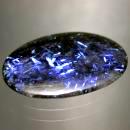|
|
||||||||||||||||
|
||||||||||||||||
|
||||||
|
|
|
|
Sahara
Nuummite
(variety
of Nuummite) |
|
| | |
| Discovered in 2009; IMA status: Not Valid (trade name) | ||
|
| ||
|
Chemistry |
|
|
| |
|
(Mg2)(Mg5)Si8O22(OH)2 + Ti | |
|
|
Magnesium Silicate Hydroxide + titanium |
|
|
|
|
More Information |
|
|
|
|
|
|
Sahara
Nuummite is a variety of Nuummite. |
|
Synonyms: |
Jenakite, Nuummite, Sahara Nuummite |
|
|
|
|
Several samples of this new material were donated to GIA by Scott Davies of American-Thai Trading in Bangkok. This Nuummite from Mauritania has iridescence that is mostly blue to bluish green, although some stones show golden yellow and a small percentage are a highly desirable pure blue. Unlike the original Greenland rocks, the new Sahara Nuummite often has a high density of needles, some of which can show a quite attractive blue color. The blue color is said to be due to the presence of titanium. The stones take a good polish, but cutting the material is challenging as the colorful iridescent needles only appear in very thin planes with a very narrow viewing orientation in the rough making yields low. Raman
spectra of the iridescent laths were consistent with
Anthophyllite and Gedrite, which are orthorhombic members
in the magnesium-iron-manganese-lithium amphibole group.
Testing confirmed that the flashy needles are in fact
the amphibole Anthophyllite, the main component of Nuummite.
The samples had RI measurements between 1.649 and 1.669,
consistent with the Raman identification. Hydrostatic
specific gravity was 2.98 ± 0.05, and the samples were
inert to long- and short-wave UV radiation. |
|
|
We
have not photographed our Sahara Nuummite
gems. Please
check back soon. |
